Related Research Articles

Incheon, formerly Jemulpo or Chemulp'o (제물포) until the period after 1910, officially the Incheon Metropolitan City, is a city located in northwestern South Korea, bordering Seoul and Gyeonggi to the east. Inhabited since the Neolithic, Incheon was home to just 4,700 people when it became an international port in 1883. Today, about 3 million people live in the city, making it South Korea's third-most-populous city after Seoul and Busan.

Deoksugung (Korean: 덕수궁) also known as Gyeongun-gung, Deoksugung Palace, or Deoksu Palace, is a walled compound of palaces in Seoul that was inhabited by members of Korea's royal family during the Joseon monarchy until the annexation of Korea by Japan in 1910. It is one of the "Five Grand Palaces" built by the kings of the Joseon dynasty and designated as a Historic Site. The buildings are of varying styles, including some of natural cryptomeria wood), painted wood, and stucco. Some buildings were built of stone to replicate western palatial structures.

Gyeongbokgung, also known as Gyeongbokgung Palace, was the main royal palace of the Joseon dynasty. Built in 1395, it is located in northern Seoul, South Korea. The largest of the Five Grand Palaces built by the Joseon dynasty, Gyeongbokgung served as the home of the royal family and the seat of government.

Changdeokgung, also known as Changdeokgung Palace or Changdeok Palace, is set within a large park in Jongno District, Seoul, South Korea. It is one of the "Five Grand Palaces" built by the kings of the Joseon dynasty (1392–1897). As it is located east of Gyeongbok Palace, Changdeokgung—along with Changgyeonggung—is also referred to as the "East Palace".

Seongnam is the fourth largest city in South Korea's Gyeonggi Province after Suwon and the 10th largest city in the country. Its population is approximately one million. Seongnam is a satellite city of Seoul. It is largely a residential city located immediately southeast of Seoul and belongs to the Seoul Capital Area.
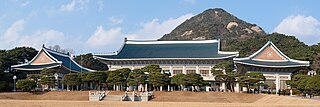
Cheong Wa Dae, also known as the Blue House in English, is a public park that formerly served as the presidential residence and the diplomatic reception halls of South Korea from 1948 to 2022. It is located in the Jongno district of the South Korean capital Seoul.

The Catholic University of Korea is a private Roman Catholic university in Bucheon-si, Gyeonggi-do, South Korea. It was established in 1855. The Catholic University of Korea operates campuses in Seoul and in the neighboring Bucheon City. The university's school of medicine operates eight affilated hospitals throughout the country.
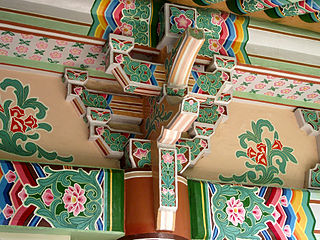
Korean architecture refers to an architectural style that developed over centuries in Korea. Throughout the history of Korea, various kingdoms and royal dynasties have developed a unique style of architecture with influences from Buddhism and Korean Confucianism.
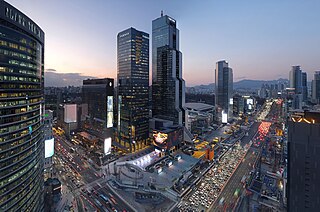
Gangnam District is one of the 25 districts of Seoul, South Korea. The term Gangnam translates to "South of the [Han] River". Gangnam District is the third largest district in Seoul, with an area of 39.5 km2 (15.3 sq mi). As of the 2017 census, Gangnam District had a population of 561,052. There is a high concentration of wealth in the district, with prices for an apartment as of 2020 nearly double those in the rest of Seoul. Gangnam District is part of Gangnam School District Eight, along with the Seocho District. This district shares half of Gangnam-daero Gangnam Station area with Seocho District, which is one of the most crowded places in South Korea.

Kookmin University is a private research university established in 1946 in Seongbuk-gu, Seoul, South Korea. It has historic significance, as it was founded during by the Provisional Government of the Republic of Korea and is the first private university founded after the liberation of the Republic of Korea from Japan.
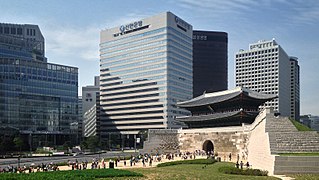
Jung District is one of the 25 districts of Seoul, South Korea.
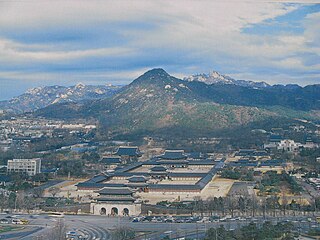
Jongno District is a district in central Seoul, South Korea. It is the historic center of Seoul, and contains the Joseon-era royal palace Gyeongbokgung and the former presidential residence, the Blue House.

Seoul, officially Seoul Special City, serves as the capital of South Korea, and is its most extensive urban center. The broader Seoul Capital Area, encompassing Gyeonggi province and Incheon metropolitan city, emerged as the world's fourth largest metropolitan economy in 2014, trailing only Tokyo, New York City, and Los Angeles, hosting more than half of South Korea's population. Although Seoul's population peaked at slightly over 10 million, it has gradually decreased since 2014, standing at approximately 9.97 million residents as of 2020. Seoul is the seat of the Korean government.

Hyun Jung-hwa is a retired table tennis player from South Korea who competed in the 1988 Summer Olympics, and in the 1992 Summer Olympics.

CJ ENM Entertainment Division, formerly known as CJ E&M, is a South Korean entertainment and mass media division of CJ ENM. In July 2018, the company merged with the parent company's subsidiary CJ O Shopping, with the latter being the surviving entity.
Kyu Sung Woo is a South Korean architect and principal of the architectural design firm, Kyu Sung Woo Architects, Inc. The firm's projects include many built and proposed works in the United States and South Korea.

Kim Seong-Kon, also known as Seong-Kon Kim, is a South Korean academic, literary critic, film critic, columnist, editor and writer.
The following is a timeline of the history of the city of Seoul, South Korea.

CJ ENM Co., Ltd is a South Korean entertainment and retail company founded in 2018.

The New Millennium Hall It is the name given to a multipurpose structure located in North Chungcheong Province in the city of Seoul, capital of South Korea. It is a university auditorium, university administrative building and concert hall. It is a privately owned facility that is part of the Konkuk University campus (건국대학교) and has been used over the years for numerous events, concerts, cultural Conferences and student activities and more. New Millennium Hall is situated nearby to International House, and close to University Residence C.